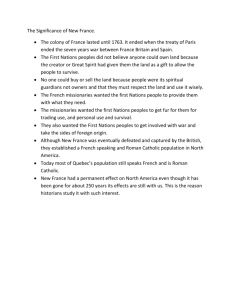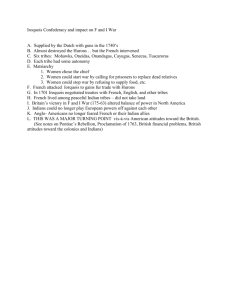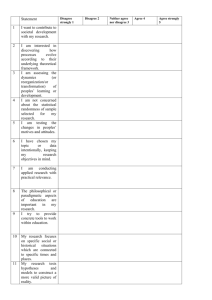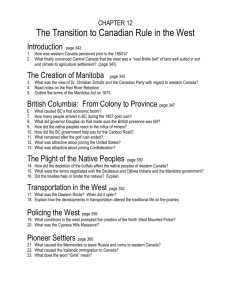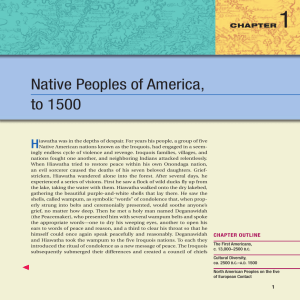PreColumbiaandeuropevocab
advertisement
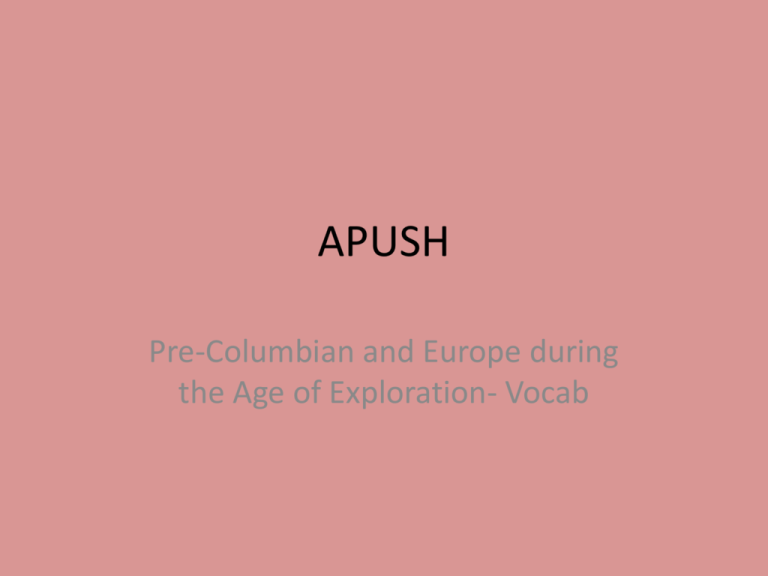
APUSH Pre-Columbian and Europe during the Age of Exploration- Vocab Pangaea • Gigantic common landmass Continental Drift • About 240 million years ago, powerful tectonic forces fractured Pangaea and slowly pushed the continents into their present positions. Homo Sapiens • Modern humans Beringia • A land bridge connecting Asian Siberia and American Alaska. Paleo-Indians • The first migrants across Beringia who arrived sometime after 15,000 BP and definitely by 13,500 BP. Clovis Point • An early Paleo-Indian spearhead named for the place in New Mexico where it was first excavated. Archaic Indians • North American peoples who lived sometime between 10,000 BP to somewhere between 4000 and 3000 BP. Great Basin Indians • Archaic peoples who lived between the Rocky Mountains and the Sierra Nevadas. Woodland Peoples • East of the Mississippi River, Archaic peoples adapted to a forest environment such as those located in the major river valleys of the Mississippi, Ohio, Tennessee and Cumberland; the Great Lakes region and the East Coast. Mogollon Cultures • Small farming settlements located throughout southern New Mexico at about AD 200. Hohokam Culture • About AD 500 in southern Arizona agrarian based settlements used sophisticated grids of irrigation canals to plant and harvest crops twice a year. Adena Peoples • Between 2500 BP and 2100 BP, these peoples built hundreds of burial mounds radiating from central Ohio. Hopewell Culture • About 2100 BP, Adena culture evolved into the more elaborate Hopewell culture which lasted about 500 years. Algonquian • Tribes that inhabited the Atlantic seaboard, the Great Lakes region and much of the Upper Midwest. Iroquoian • Occupied territories centered in Pennsylvania, upstate New York as well as the Carolinas and New York. Mississippian Culture • Emerged in the floodplains of the major southeastern river system about AD 800 and lasted until about AD 1500. League of Five Nations • Confederation of Native Americans who included the following tribes: Seneca, Onondaga, Mohawk, Oneida and Cayuga. Muskogean • Spread throughout the woodlands of the southeast, south of the Ohio River and east of the Mississippi River. Including the Creek, Choctaw, Chickasaw and Natchez tribes. The Dalles • A prime fishing site on the Colombia River on the border of present-day Oregon and Washington. Mexica • Empire that stretched from coast to coast across central Mexico, encompassing between 8 and 25 million people. Prince Henry the Navigator • The most important advocate of Portuguese exploration. He collected the latest information about sailing techniques and geography, supported new crusades against Muslims, sought fresh sources of trade and pushed exploration deeper into new areas. Malinali • A young Amerindian girl gifted to Cortes by the Tabasco Indians. She spoke several languages including, Nahuatl, the language of the Aztecs and acted as an interpreter and liaison for Cortes. St. Augustine, Florida • In 1565 the Spanish king sent Pedro Menendez de Aviles to create settlements along the Atlantic Coast of North America. In early September, he founded St. Augustine, the first permanent European settlement in the U.S. Acoma Pueblo Revolts • 1599 revolt against the Spanish settlers led by Juan de Onate in the New Mexico pueblo of Acoma. Repartimiento • 1549 reform that began to replace encomienda. It limited the labor the encomendero could command from his Indians to 45 days per year from each adult male.


